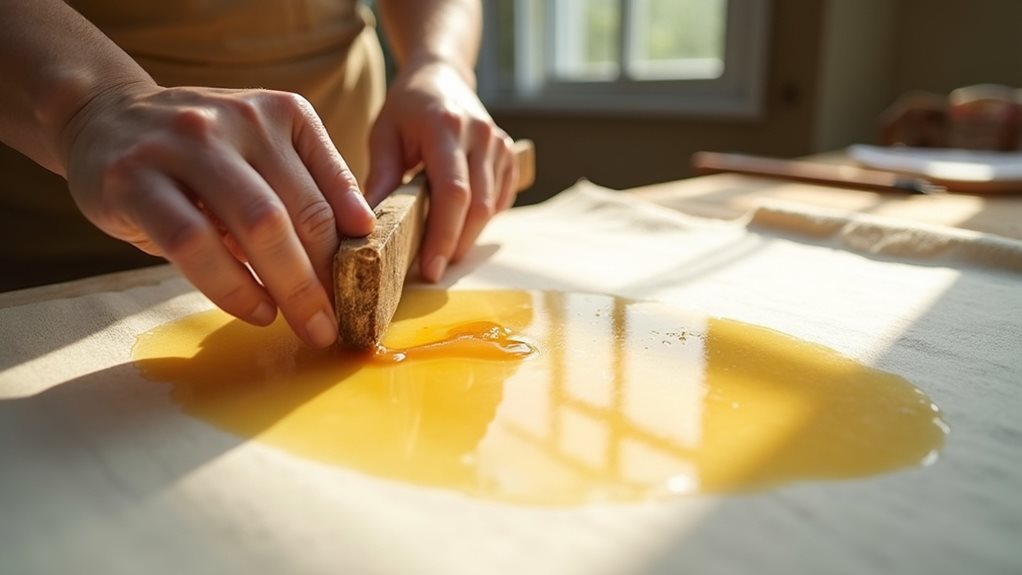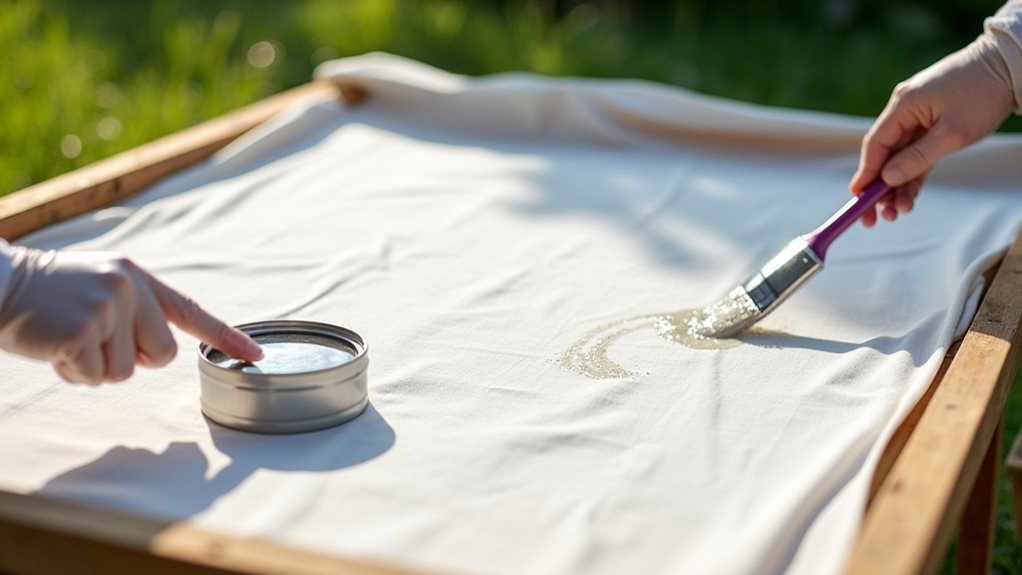To waterproof cotton fabric for outdoor use, start by thoroughly cleaning and drying your material. Choose between natural options like beeswax or synthetic sprays, depending on your needs for breathability and durability. Apply your chosen waterproofing agent evenly across the fabric’s surface, following the manufacturer’s instructions for proper coverage. After treatment, allow the fabric to cure completely in a well-ventilated area. Understanding additional techniques and maintenance practices will guarantee long-lasting water resistance.
TLDR
- Clean and thoroughly dry the cotton fabric before applying any waterproofing treatment to ensure proper absorption and effectiveness.
- Apply a PFAS-free waterproofing spray or natural beeswax coating evenly across the fabric surface using appropriate protective gear.
- Test the waterproofing solution on a small area first to check for any adverse reactions or unwanted color changes.
- Allow the treated fabric to cure completely in a well-ventilated area for 24-48 hours before outdoor use.
- Maintain waterproofing effectiveness by reapplying treatment regularly, especially after washing or when water stops beading on the surface.
Understanding Cotton’s Natural Properties

While cotton stands as one of the most versatile and widely used natural fibers, its relationship with water is complex and important to understand before attempting any waterproofing treatment.
You’ll find that cotton naturally absorbs 8.5% moisture in its raw state, increasing to 15-25% in normal conditions, making it highly absorbent yet prone to water retention. Cotton’s natural plant fibers provide exceptional breathability and comfort, which can affect waterproofing applications. Additionally, cotton’s lack of inherent water resistance makes it essential to employ effective waterproofing techniques when using the fabric outdoors.
While it’s stronger when wet, it’s naturally lacking in water resistance.
Essential Tools and Materials
The successful waterproofing of cotton fabric depends heavily on gathering the right combination of tools and materials before you begin.
You’ll need basic items like a hair dryer, brushes, and protective gear, along with your chosen waterproofing agent. Proper surface preparation, such as sanding the fabric, can enhance the effectiveness of the waterproofing process.
Whether you’re using natural options like beeswax and linseed oil or synthetic products like PFAS-free sprays, don’t forget protective surfaces and application tools. A single waterproofing bar can effectively treat between 20 to 60 square feet of fabric, depending on the material’s thickness.
Pre-Treatment Fabric Preparation

Proper preparation of your cotton fabric serves as the foundation for successful waterproofing, making it crucial to start with a thoroughly clean and properly dried material.
Before applying any treatments, wash your fabric with a gentle detergent to remove dirt and debris, then confirm it’s completely dry.
You’ll also want to test a small, inconspicuous area first to check for any adverse reactions. This step is similar to the visual inspection method used to differentiate between plaster and drywall, ensuring you don’t encounter unforeseen issues.
Popular Waterproofing Methods
Now that your fabric is clean and ready, several effective methods exist for waterproofing cotton fabric, each offering distinct advantages and potential trade-offs.
You’ll find spray-on treatments particularly convenient, as they maintain fabric breathability while providing reliable protection.
Natural options like beeswax create durable barriers but may alter texture, while synthetic coatings using silicone or polyurethane offer strong, long-lasting water resistance. Additionally, consider the environmental impact of your waterproofing choice, as using sustainable gardening practices can help reduce reliance on non-renewable resources.
Step-by-Step Application Guide

Successfully waterproofing cotton fabric requires careful attention to detail and a systematic approach throughout the application process.
Begin by thoroughly cleaning your fabric and letting it dry completely.
Apply your chosen waterproofing treatment in thin, even layers, working systematically across the surface.
Don’t rush between coats; allow proper drying time to guarantee maximum water resistance and durability of the treatment.
Drying and Curing Techniques
The drying and curing phase of waterproofing cotton fabric requires just as much attention as the application process itself.
You’ll need to air dry your treated fabric in a well-ventilated area, avoiding direct heat or machine drying.
Allow the fabric to cure overnight in a warm environment, and don’t forget to protect it from dust with a clean covering.
Once cured, test the waterproofing by checking if water beads up.
Maintenance and Care Tips

Maintaining your waterproofed cotton fabric’s effectiveness requires consistent care and attention to detail throughout its lifetime.
You’ll need to regularly reapply waterproof coatings, especially after washing or heavy use, and store your fabric in cool, dry places.
Clean with gentle detergent and lukewarm water, avoid folding by rolling instead, and inspect frequently for signs of wear at seams and corners.
Testing Water Resistance
Testing your waterproofed cotton fabric’s effectiveness involves several standardized methods that’ll help you assess its water resistance capabilities.
You can perform the AATCC spray test to visually evaluate water repellency, or use the hydrostatic pressure test to measure precise resistance levels.
For thorough results, you’ll want to conduct the 8-inch for 10-minute test, which checks for leakage under sustained water exposure.
Final Note
You’ve now learned several effective methods to waterproof your cotton fabric for outdoor use, and it’s important to remember that proper application and maintenance are key to long-lasting results. While no waterproofing solution is permanent, you’ll extend the life of your treated fabric by regularly testing its water resistance and reapplying treatments as needed. With these techniques, you can confidently protect your cotton items from water damage and extend their outdoor functionality.